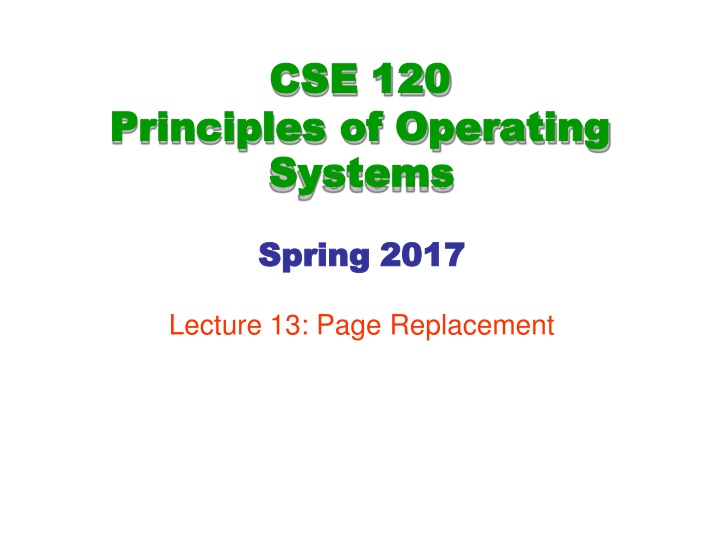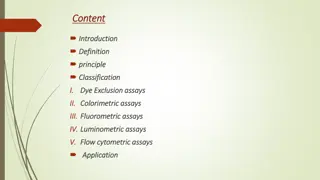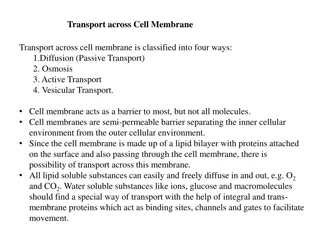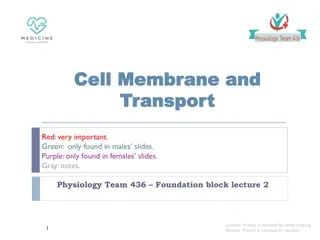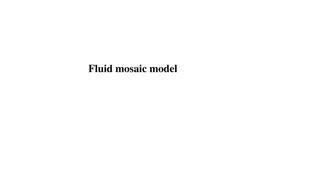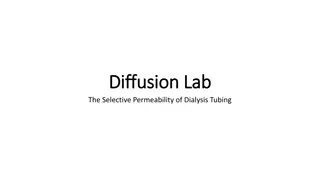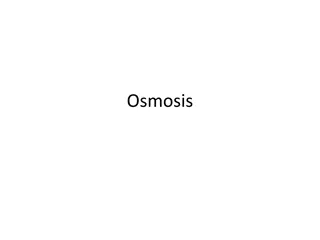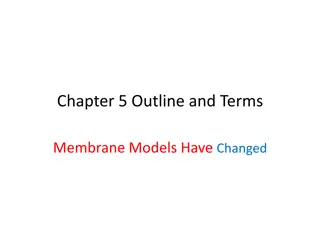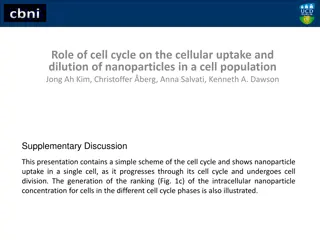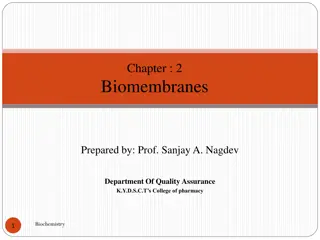Cell Membrane Transport and Permeability
Cell membrane, also known as the plasma membrane, is selectively permeable, allowing certain molecules to pass while blocking others. This permeability is vital for cellular function, regulating the passage of molecules like gases, water, and ions. The membrane facilitates various types of transport, such as simple diffusion, channel diffusion, facilitated diffusion, active transport, endocytosis, and exocytosis. Understanding the mechanisms of molecular movement through the membrane, including osmosis and the role of channel proteins, is crucial in the study of cytology.
Download Presentation

Please find below an Image/Link to download the presentation.
The content on the website is provided AS IS for your information and personal use only. It may not be sold, licensed, or shared on other websites without obtaining consent from the author.If you encounter any issues during the download, it is possible that the publisher has removed the file from their server.
You are allowed to download the files provided on this website for personal or commercial use, subject to the condition that they are used lawfully. All files are the property of their respective owners.
The content on the website is provided AS IS for your information and personal use only. It may not be sold, licensed, or shared on other websites without obtaining consent from the author.
E N D
Presentation Transcript
CSE CSE 120 of Operating Operating Systems Systems 120 Principles Principles of Spring Spring 201 2017 7 Lecture 13: Page Replacement
Memory Memory Management Management Final lecture on memory management: Goals of memory management To provide a convenient abstraction forprogramming To allocate scarce memory resources among competing processes to maximize performance with minimal overhead Mechanisms Physical and virtual addressing (1) Techniques: Partitioning, paging, segmentation(1) Page table management, TLBs, VM tricks(2) Policies Page replacement algorithms(3) May 19,2016 CSE 120 Lecture 11 PageReplacement 2
Lecture Lecture Overview Overview Review paging and page replacement Survey page replacement algorithms Discuss local vs. global replacement Discuss thrashing May 19,2016 CSE 120 Lecture 11 PageReplacement 3
Locality Locality All paging schemes depend on locality Processes reference pages in localized patterns Temporal locality Locations referenced recently likely to be referencedagain Spatial locality Locations near recently referenced locations are likely tobe referenced soon Although the cost of paging is high, if it is infrequent enough it is acceptable Processes usually exhibit both kinds of locality during their execution, making paging practical May 19,2016 CSE 120 Lecture 11 PageReplacement 4
Demand Demand Paging Paging (OS) (OS) Recall demand paging from the OS perspective: Pages are evicted to disk when memory isfull Pages loaded from disk when referencedagain References to evicted pages cause a TLB miss PTE was invalid, causesfault OS allocates a page frame, reads page fromdisk When I/O completes, the OS fills in PTE, marks it valid, and restarts faulting process Dirty vs. clean pages Actually, only dirty pages (modified) need to be written todisk Clean pages do not but you need to know where on diskto read them from again May 19,2016 CSE 120 Lecture 11 PageReplacement 5
Demand Demand Paging Paging (Process) (Process) Demand paging is also used when a process first starts up When a process is created, it has A brand new page table with all valid bits off No pages in physical memory When the process starts executing Instructions fault on code and datapages Faulting stops when all necessary code and data pages arein memory Only code and data needed by a process needs to beloaded This, of course, changes overtime May 19,2016 CSE 120 Lecture 11 PageReplacement 6
Page Page Replacement Replacement When a page fault occurs, the OS loads the faulted page from disk into a page frame of memory At some point, the process has used all of the page frames it is allowed to use This is likely (much) less than all of available memory When this happens, the OS must replace a page for each page faulted in It must evict a page to free up a pageframe The page replacement algorithm determines how this is done And they come in all shapes and sizes May 19,2016 CSE 120 Lecture 11 PageReplacement 7
Evicting Evicting the Best the Best Page Page The goal of the replacement algorithm is to reduce the fault rate by selecting the best victim page to remove The best page to evict is the one never touched again Will never fault on it Never is a long time, so picking the page closest to never is the next best thing Evicting the page that won t be used for the longest periodof time minimizes the number of pagefaults Proved by Belady We re now going to survey various replacement algorithms, starting with Belady s May 19,2016 CSE 120 Lecture 11 PageReplacement 8
Beladys Belady s Algorithm Algorithm Belady s algorithm is known as the optimal page replacement algorithm because it has the lowest fault rate for any page reference stream Idea: Replace the page that will not be used for thelongest time in the future Problem: Have to predict thefuture Why is Belady s useful then? Use it as a yardstick Compare implementations of page replacement algorithms with the optimal to gauge room forimprovement If optimal is not much better, then algorithm is prettygood If optimal is much better, then algorithm could use somework Random replacement is often the lower bound May 19,2016 CSE 120 Lecture 11 PageReplacement 9
First First- -In First In First- -Out Out (FIFO) (FIFO) FIFO is an obvious algorithm and simple to implement Maintain a list of pages in order in which they were pagedin On replacement, evict the one brought in longest timeago Why might this be good? Maybe the one brought in the longest ago is not beingused Why might this be bad? Then again, maybe it s not We don t have any info to say one way or theother FIFO suffers from Belady sAnomaly The fault rate might actually increase when the algorithmis given more memory (verybad) May 19,2016 CSE 120 Lecture 11 PageReplacement 10
Least Recently Least Recently Used Used (LRU) (LRU) LRU uses reference information to make a more informed replacement decision Idea: We can t predict the future, but we can make a guess based upon past experience On replacement, evict the page that has not been used forthe longest time in the past (Belady s:future) When does LRU do well? When does LRU do poorly? Implementation To be perfect, need to time stamp every reference(or maintain a stack) much toocostly So we need to approximateit May 19,2016 CSE 120 Lecture 11 PageReplacement 11
Approximating Approximating LRU LRU LRU approximations use the PTE reference bit Keep a counter for eachpage At regular intervals, for every pagedo: If ref bit = 0, incrementcounter If ref bit = 1, zero thecounter Zero the referencebit The counter will contain the number of intervals since thelast reference to thepage The page with the largest counter is the least recentlyused Some architectures don t have a reference bit Can simulate reference bit using the valid bit to induce faults What happens when we make a pageinvalid? May 19,2016 CSE 120 Lecture 11 PageReplacement 12
LRU LRU Clock Clock (Not (Not Recently Recently Used) Used) Not Recently Used (NRU) Used by Unix Replace page that is old enough Arrange all of physical page frames in a big circle(clock) A clock hand is used to select a good LRUcandidate Sweep through the pages in circular order like a clock If the ref bit is off, it hasn t been usedrecently What is the minimum age if ref bit is off? If the ref bit is on, turn it off and go to nextpage Arm moves quickly when pages areneeded Low overhead when plenty of memory If memory is large, accuracy of information degrades What does it degradeto? One fix: use two hands (leading erase hand, trailing select hand) May 19,2016 CSE 120 Lecture 11 PageReplacement 13
Example: gcc Page Example: gcc Page Replace Replace May 19,2016 CSE 120 Lecture 11 PageReplacement 14
Example: Example: Belady s Anomaly Belady s Anomaly May 19,2016 CSE 120 Lecture 11 PageReplacement 15
Fixed Fixed vs. vs. Variable Variable Space Space In a multiprogramming system, we need a way to allocate memory to competing processes Problem: How to determine how much memory to give to each process? Fixed space algorithms Each process is given a limit of pages it canuse When it reaches the limit, it replaces from its own pages Localreplacement Some processes may do well while others suffer Variable space algorithms Process set of pages grows and shrinks dynamically Globalreplacement One process can ruin it for the rest May 19,2016 CSE 120 Lecture 11 PageReplacement 16
Working Working Set Set Model Model A working set of a process is used to model the dynamic locality of its memory usage Defined by Peter Denning in 60s Definition WS(t,w) = {pages P such that P was referenced in thetime interval (t, t-w)} t time, w working set window (measured in pagerefs) A page is in the working set (WS) only if it was referenced in the last w references May 19,2016 CSE 120 Lecture 11 PageReplacement 17
Working Working Set Set Size Size The working set size is the number of unique pages in the working set The number of pages referenced in the interval (t,t-w) The working set size changes with program locality During periods of poor locality, you reference morepages Within that period of time, the working set size islarger Intuitively, want the working set to be the set of pages a process needs in memory to prevent heavy faulting Each process has a parameter w that determines aworking set with few faults Denning: Don t run a process unless working set is in memory May 19,2016 CSE 120 Lecture 11 PageReplacement 18
Example: gcc Example: gcc Working Working Set Set May 19,2016 CSE 120 Lecture 11 PageReplacement 19
Working Working Set Set Problems Problems Problems How do we determinew? How do we know when the working set changes? Too hard to answer So, working set is not used in practice as a pagereplacement algorithm However, it is still used as an abstraction The intuition is still valid When people ask, How much memory does Firefox need? , they are in effect asking for the size of Firefox s workingset May 19,2016 CSE 120 Lecture 11 PageReplacement 20
Page Page Fault Frequency Fault Frequency (PFF) (PFF) Page Fault Frequency (PFF) is a variable space algorithm that uses a more ad-hoc approach Monitor the fault rate for eachprocess If the fault rate is above a high threshold, give it morememory So that it faultsless But not always (FIFO, Belady sAnomaly) If the fault rate is below a low threshold, take awaymemory Should faultmore But notalways Hard to use PFF to distinguish between changes in locality and changes in size of working set May 19,2016 CSE 120 Lecture 11 PageReplacement 21
Thrashing Thrashing Page replacement algorithms avoid thrashing When most of the time is spent by the OS in paging databack and forth fromdisk Little time spent doing useful work (making progress) In this situation, the system is overcommitted No idea which pages should be in memory to reduce faults Could just be that there isn t enough physical memory for all of the processes in the system Ex: Running Windows95 with 4 MB of memory Possible solutions Swapping write out all pages of a process Buy morememory May 19,2016 CSE 120 Lecture 11 PageReplacement 22
Summary Summary Page replacement algorithms Belady s optimal replacement (minimum # offaults) FIFO replace page loaded furthest inpast LRU replace page referenced furthest inpast Approximate using PTE referencebit LRU Clock replace page that is old enough Working Set keep the set of pages in memory thathas minimal fault rate (the workingset ) Page Fault Frequency grow/shrink page set as a functionof fault rate Multiprogramming Should a process replace its own page, or that ofanother? May 19,2016 CSE 120 Lecture 11 PageReplacement 23
Next Next time time Read Chapters 37, 39, 40 May 19,2016 CSE 120 Lecture 11 PageReplacement 24
